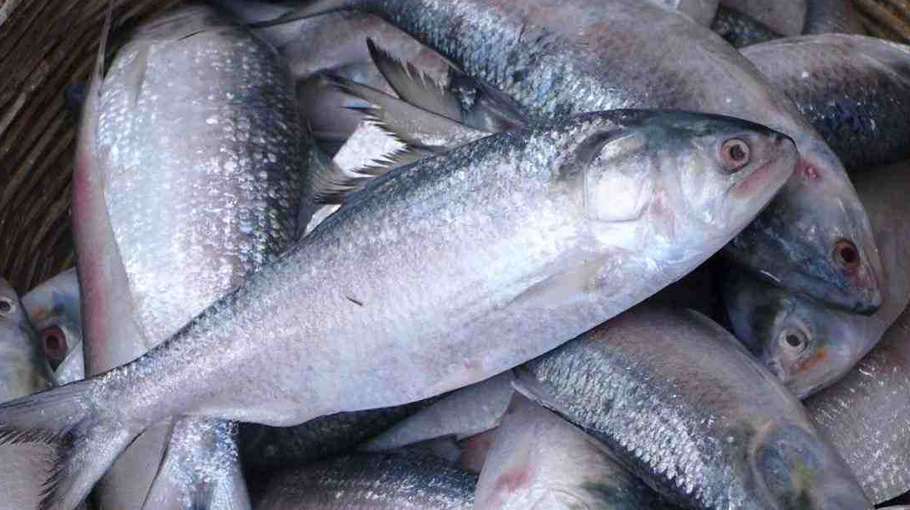
It started raining for three days. For the harvest, it has brought good news for the hilsha lovers. In the last two days, about 1,000 maunds of hilsa have arrived at Chandpur’s fish landing center. However, fishermen and traders say that last year at the same time two to three thousand maunds of hilsa were coming in a day. This time Hilsa is less, and the price is too high.
Abdul Bari Jamadar, President of Chandpur Fishery Merchants Association, told Prothom Alo that since the last two months, there has been little rain, and there has been little hilsa in the river. Although it is starting to come now, it is not even a third of the same period last year.
The scientists of the Fisheries Research Institute think that the growth rate of hilsa production in the country is decreasing mainly due to three reasons.
According to Bangladesh Fisheries Department, after 2007-08, hilsa production increased by 3 percent in the country.
In the fiscal year 2018-19, 5 lacks 32 thousand tons of hilsa were caught. Hilsa production increased by 3.02 percent compared to the previous year. In the fiscal year 2019-20, the extraction increased by 3.32 percent to 5 lakh 50 thousand tons. In 2020-21, it increased by 2.68 percent to 5 lakh 65 thousand tons. And in the fiscal year 2021-22, 5.65 thousand tons were extracted with an increase of 0.25 percent. However, many people have questions about this account.
The Fisheries Research Institute conducts a survey on the number of eggs laid by Hilsa each year. It showed that the egg-laying rate of increased by 11 percent in 2022 compared to 2018. Usually, the grows to the same extent as the egg grows. But during the same period, the production of increased by about 6 percent; That is, the increase in production is half of the egg-laying rate.
When asked, Professor Sajjad Hossain of the Aquaculture Department of Bangladesh Agricultural University told Prothom Alo that the price of hilsa has been very high in the market for the last two to three years.
Those who catch these fish have no major expenses other than the cost of boat hire and oil. Still, hilsa is being sold at the rate of 150-2000 taka per kg. That means, the amount of hilsa being extracted is not correct.
According to the scientists of the Fisheries Research Institute, among the three reasons that the growth rate of hilsa production in the country is decreasing, firstly, there are many obstacles in the way of hilsa coming from the sea to the estuaries of the country. The Meghna Basin of the country is now the largest breeding center of Hilsa. 56 percent of the annual production in the country comes from the Bay of Bengal. 30 percent comes from the Meghna basin and the remaining 4 percent is from the Padma river. At least one and a half hundred divers have formed on the way of Hilsa flocks coming from the sea to the Meghna. Hilsa is not able to come as much because of this fodder.
Second, pollution has increased over a large area from the Meghna to the Padma. At the same time, the organic food required for fish in the river has decreased. According to the Fisheries Research Institute, the rate of decline in the food supply in the last four years is 6 percent. And because of pollution, is not coming to the river, even if it comes, it is quickly moving away.
As a result, less hilsa is coming to the river.
Thirdly, there has been a change in the monsoon pattern of the country. Due to the new water and tides of the monsoon, hilsa comes more from the sea to the river at this time. According to the Meteorological Department, July last year received 58 percent less rain than normal. In July this year, it fell by 50 percent. Hilsa is also less caught due to less rain.
If asked, Senior Scientific Officer of Fisheries Research Institute, River Center, Chandpur. Ashraful Alam told Prothom Alo, apart from those three barriers, fishermen sit to get huge long nets on the way from the sea to the river. As a result, cannot enter the river easily. He said the reason for the increase in hilsa production not increasing in parallel with the increase in egg laying, many eggs are not properly fertilized due to pollution and high sedimentation. That’s why the number of fish may not be increasing at the same rate as spawning.
Fishery experts blame another factor behind the decline in the growth rate of production. They say that the Bangladesh government is strictly following the 65-day ban on fishing in the sea. But at the same time, neighboring countries of Bangladesh are taking fish from the sea without following the ban.
Head of Hilsa Branch of Bangladesh Fisheries Department, Masud Ara Momi told Prothom Alo, “There was less Hilsa coming from the sea to the river due to lack of rain for so long. Now the rain has increased. Hilsa is also being caught.
Hilsa is being caught in the sea, fishermen and traders are relieved
Fishermen in the south hoped that there would be plenty of hilsa if the ban on fishing in the Bay of Bengal was lifted. But even though the 65-day ban ended a week ago, not much was caught in the rivers and seas. Millions of fishermen and traders were disappointed. The fish landing centers in the region were starving for lack of fish. But since last Monday, when hilsa was caught in the sea, the frustration of the sea.